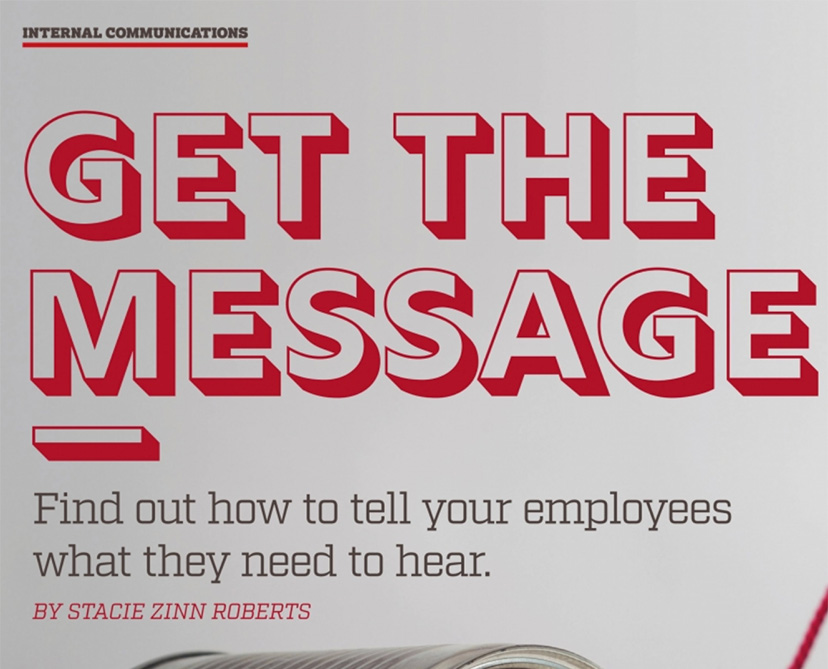Internal Communications: Find out how to tell your employees what they need to hear.
When Scott Needham noticed inconsistencies in the way his landscape crews were pruning shrubs in the common areas of the dozens of homeowners associations his company, ProQual Landscaping, maintains in Tempe, Arizona, he knew he had to find a way to show his crews how to do it correctly. But demonstrating one-on-one how he wanted the pruning performed for each of his 150 crew members across 30 different maintenance crews was not practical.
Instead, he hired a production company to shoot a video of one of his crews pruning correctly. The video was shown to crew members at early morning meetings. And now, shrubs at every job site are pruned in exactly the same way.
How do you communicate with your employees? Whether you’ve got one small crew or an army of hundreds, the challenge remains the same. How can landscape managers and irrigation installers effectively communicate tasks, express company culture and get employees to buy into company objectives in a way that will not only be well received, but implemented? Needham devised a creative way to get the message out to his staff, and you can too.
Judith Guido is a business consultant and founder of Guido and Associates, Moorpark, California. She specializes in helping green industry companies grow their businesses. Internal communications is a frequent focus of her work with new clients.
“When I ask what some of the biggest problems are in their company, 99% of the time, the word ‘communication’ is one of the top three responses,” Guido says. “I ask the question, ‘Could you share with me what your communications strategy is?’ And quite frequently you get a pregnant pause followed by, ‘What do you mean, communications strategy?’” According to Guido, an internal communications strategy is organizing the flow of information that’s necessary to run your company in a predictable, efficient and time-sensitive manner. And that information has got to go out to the right people.
Effective internal communication dictates how information is shared within an organization. Guido recommends that organizations break down the functions of an organization and map out workflows. Once the way the company works is understood, the messaging necessary to assist in keeping those workflows moving is what should be communicated to staff.
“I think communication is one of the most important aspects of our business because we’re in the service business. Our reputation is upheld with follow-through on commitments,” says Chris Angelo, president and CEO of Stay Green Inc., Santa Clarita, California, a commercial landscaping and irrigation services company. “So if we make a commitment, we’ve got to honor that commitment. And that’s why communication is number one — so that we retain clients and retain team members.”
Founded in 1970 by Angelo’s parents, Richard and Charlene, the company has grown to 10 locations and 400 employees. With so many employees spread from San Diego to Santa Barbara, Angelo says getting everyone on the same page is critical. To do so, he and his company leadership devised a strategy that they implement on a daily basis.
“We have, as an organization, identified the core values that are important to us. And honestly, those core values really are aligned with me and my father’s personal and traditional values,” Angelo says. “A way to really illustrate the idea or the values is to align it with a behavior or a type of action or outcome you would like to have.”
Stay Green’s four core values
• Teamwork
• Achievement
• Accountability
• Integrity
Under each of the four core values, Stay Green lists between four and six behaviors that illustrate ways crew members can align with company philosophy.
For example, under teamwork, behavior #3 is:
Practice blameless problem-solving
Just fix it. Apply your creativity and enthusiasm to developing solutions, rather than pointing fingers or dwelling on problems. Identify lessons learned and use those lessons to improve ourselves and our processes so we don’t make the same mistake twice. Learn from every experience.
The core values are written down. They’re printed on cards that each employee carries. Every week, one of these is designated as the Value Behavior of the Week and it is incorporated into morning meetings that Angelo calls huddles.
“In our morning huddles we will share the Value Behavior of the Week, and we’ll give an example of why it’s important. Then I’ll send it out via text in English and Spanish to all of the company’s phones and emails on a daily basis,” Angelo says. “And so that really helps set culturally the tone for the company and the importance of how we communicate with one another.”
Since Stay Green introduced this program of value behavior daily reinforcement six years go, Angelo reports measurable results.
“We have had a reduction in employee turnover at the skilled level. We have had almost a perfect score at the leadership team level. We have improved our client retention, and our client survey scores over the last six years incrementally have improved. We have drastically improved our safety, and our experience modification has dropped below 100 and held for the first time in decades,” Angelo says.
Experience modification is a workers’ compensation safety measurement that impacts insurance rates. “Safety is critical because insurance is expensive, particularly in California. If you have more frequency of accidents, or severity of accidents, that cost could make your organization uncompetitive in the marketplace,” Angelo says. “We have performed very well and we’ve had a few locations where we are going on three to four years of being accident-free, which is amazing. And I believe that these trends are occurring because we are intentional about our culture of accountability, of integrity, teamwork and achievement.”
The story is similar at ProQual Landscape, where Needham spent $30,000 in 2019 to produce videos that he uses for in-house training, as well as on his company’s social media for marketing purposes.
How did the staff take to the idea of participating in videos? “You know, initially I think they thought it was weird,” Needham says. “But now they kind of look forward to it. Now they’re like, ‘Hey, when are you going to come video one of our projects?’ because they’re proud of it. So I found that since we’re trying to help them get better and help our company, they want to be a part of it. It’s increased the morale of the company.”
Another tool the ProQual teams use is the pindrop function on their iPhones to share location information between crews to accurately indicate problem areas within a landscape they manage down to the exact location. Need to get a sprinkler head fixed or report fallen tree branches? A team member will mark the location and share it with the rest of the crew, often texting a photo of the problem area for further clarification.
Guido suggests her clients pick and choose from a wide array of tools to get internal communication messaging into the hands and minds of employees.
• Smartphones: What Guido calls the “brilliant phones” offer the power of a handheld computer with calling, texting, email and other apps in the palm of your hand. You may have overlooked how useful this tool can be to send out internal messaging.
• Newsletters: Printed or digital, the good, old-fashioned company newsletter is a way to offer updates and articles that may not be time-sensitive or are too long for texts or emails.
• Video: You can hire a production company for slick, professional videos, but Guido says employee-generated videos taken with a smartphone can be just as effective.
• Project management and chat software: Project management software such as Asana, Basecamp and Monday track projects and who is assigned to specific tasks. They can also track progress in real time. Digital chat rooms like Slack allow for quick communications and file sharing for collaboration between teams.
• Social media groups: LinkedIn, Facebook and other platforms offer the ability to create private group chats or invitation-only pages that allow you to share information and photos, post training videos, and make company announcements.
• YouTube: Private YouTube channels can be created to share training videos and corporate announcements.
• Video conferencing: Platforms such as Zoom and Join.Me allow participants to share computer screens and documents and to interact with team members by video chat at different locations.
With all of these different tools available, it’s easy to become overwhelmed, but don’t be discouraged. You don’t have to use them all. Instead, try to identify the best method or tool for the job at hand. Ask yourself these four key questions:
1. What do I need to communicate?
2. Who’s going to send the communication?
3. How will the person or people I’m sending the message to best receive it?
4. What’s the best tool for the job?
Guido says sending information in several formats makes sense because some staff may work in front of a computer all day while others may never touch a keyboard.
“Different people relate differently to different tools to learn and grow and develop,” Guido says.
For example, if you’re trying to communicate with foremen in the field, sending a text to their smartphones would probably generate a quicker response than sending an email. However, texting a change to the company’s insurance policy would be ineffective. Instead, sending an email or creating a printed packet or newsletter would allow for the depth of information necessary.
Ultimately, all communications are about delivering the right message to the right person, in a way that it will be best received.
Stacie Zinn Roberts is the founder of What’s Your Avocado? Marketing and Public Relations. Connect with her on Twitter @whatsyouravocad.
This article originally appeared in the December 2019 issue of Irrigation & Green Industry

Stacie Zinn Roberts is a nationally recognized, award-winning writer and marketing expert with more than 25 years of experience. She has won more than 40 national awards for her work including the United Nations Environmental Program for retail environmental marketing, as well as from organizations such at the Public Relations Society of America and the Turf & Ornamental Communicators Association. She’s written for industry publications such as Golf Course Management, Sports Turf, Golfdom and PR Daily. She spent eight years as the president and director of marketing for Environmental Turf, where she developed the branding for SeaDwarf Seashore Paspalum, the grass that eventually became the greens grass for the Rio Olympic Golf Course. Stacie served for six years on the Board of Directors of the Florida Turfgrass Association as Chair of the Research & Scholarship Committee where she worked closely with the scientists from the University of Florida’s turfgrass breeding program. Stacie founded What’s Your Avocado? Marketing & Public Relations in 2012.


0 Comments